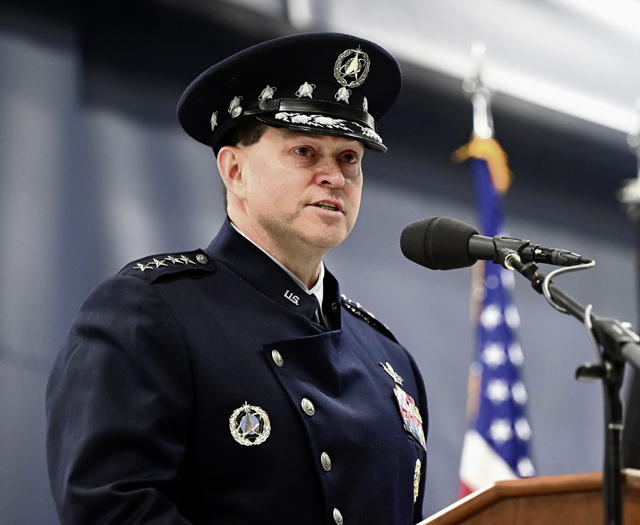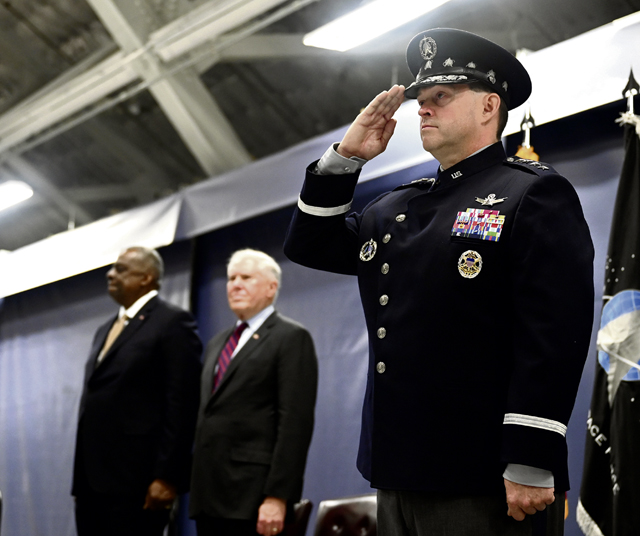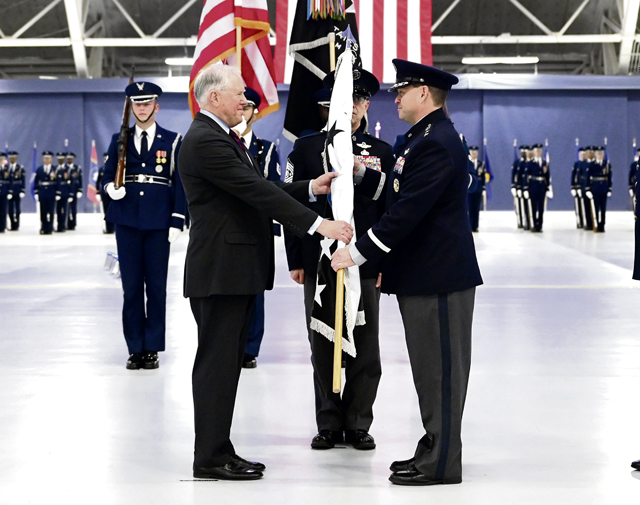
Pledging to build on the Space Force’s achievements while also infusing the nascent service with new approaches, Gen. B. Chance Saltzman was officially installed Nov. 2 as Chief of Space Operations, the service’s highest-ranking military post, and only the second person to hold the position in the Space Force’s history.
In remarks during a solemn “Change of Responsibility” ceremony, in which he was elevated to the job from retiring CSO, Gen. John “Jay” Raymond, Saltzman promised to “work relentlessly to make the Space Force the combat-ready force that our nation needs” while acknowledging it “will not be an easy or short-lived task.”
Saltzman praised Raymond for doing “the heavy lifting to establish the Space Force,” for being a mentor, and for setting the Space Force on a path on which Saltzman can build. He also thanked his wife Jennifer, his two children, and a long list of other unnamed friends and colleagues who he said comprised the “bedrock of support” across his career.
“My goal will be to provide you the resources, tools, training and experiences you need to unlock your massive potential,” he said, referring to the cadre of nearly 15,000 Guardians and civilians who currently comprise the Space Force. Saltzman said he would rely on them to continue building the Space Force and ensuring that it succeeds.

“You have my commitment that I will work relentlessly to make the Space Force the combat-ready force that our nation needs, so get ready because I’m going to need your best as well,” he said.
In addition to Raymond, Defense Secretary Lloyd Austin III, Chairman of the Joint Chiefs of Staff Gen. Mark Milley, and Department of the Air Force Secretary Frank Kendall took part in the ceremony. Vice President Kamala Harris offered a letter praising Saltzman’s selection and Raymond’s service. As CSO, Saltzman will join Milley and as a member of the Joint Chiefs of Staff.
In his remarks, Austin praised Raymond’s service and his work guiding the Space Force since its creation. He called Saltzman a worthy and capable successor. “There is no one better to take the helm than General Chance Saltzman. … For the past two years, he’s helped this new service get off the ground as a Deputy Chief of Space Operations. So, we’re lucky to have General Saltzman take the colors today.”

Saltzman’s job as CSO will be ensuring that the nearly 3-year-old Space Force continues developing and successfully achieving its broad and crucial missions. In that respect, he is well prepared. But Saltzman noted in his remarks that the stakes are high.
“The world is becoming increasingly dangerous, and preserving U.S. national security interests in space is growing harder every day,” he said. “Without the space capabilities you are designing, building, protecting, and operating, the Joint Force will not be capable of accomplishing its missions. A resilient, ready, and combat-credible Space Force is indispensable to deterrence today, tomorrow, and every day after that. In the worst case, if deterrence fails, the Space Force will be an indispensable component of our joint force at war.”
Since August 2020, Saltzman has served as Deputy Chief of Space Operations for Operations, Cyber, and Nuclear. In this role, Saltzman has overall responsibility for operations, intelligence, sustainment, cyber, and nuclear operations for the Space Force.
Commissioned in 1991 after graduating from Boston University, he has deep operational experience with missile and space systems as a Minuteman III launch officer and as a satellite operator for the National Reconnaissance Office. He also served as the first Chief of Combat Plans for the Joint Space Operations Center and, later, as Chief of Combat Operations.
Despite its small size compared to the other military services, the Space Force’s strategic importance is beyond dispute. Saltzman pledged to build on Raymond’s accomplishments. “The inspired work that General Raymond started has set us on a path,” Saltzman told the Senate Armed Services Committee Sept. 13 during his confirmation hearing. “It is a path towards advanced capabilities, modern, resilient architectures, and innovative approaches to meet our service missions.”
Saltzman inherits a Space Force as it transitions from the early planning and organizational phases required to form the first new military branch since 1947 to one that focuses more on the Department of the Air Force’s operational imperatives.
Milley used his remarks to highlight Raymond’s service, to thank him for his 38-year career and occasionally poke good-natured fun at him. Turning serious, however, Milley said Raymond “paved the way and is very much a pioneer” in the United States’ journey into space.
Space is now considered a new and indisputable “warfighting domain,” which is why the United States — primarily through the Space Force and its allies, is focusing heavily on space and adapting to the new conditions. Militarily, space has never been more essential since “space power” provides a series of foundational capabilities upon which our joint forces depend.
It wasn’t long ago when space was an exclusive club, limited almost entirely to the United States and Russia (and before that, the Soviet Union). With only two “players” roaming the vast reaches of space, it was considered a challenging but peaceful environment.
There are now 72 countries actively operating in space. That number is growing as the cost of launching vehicles into space is falling to the point that more nations, along with many commercial enterprises, are jumping in. As congestion in space increases, so too are the intentions for being there. All of that raises the stakes for operating freely and without threat in space.


